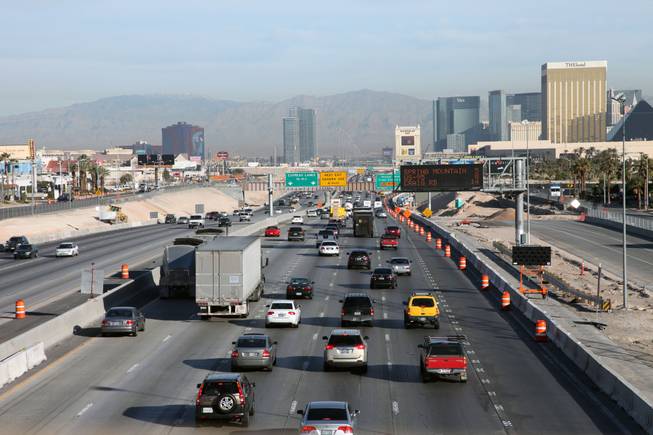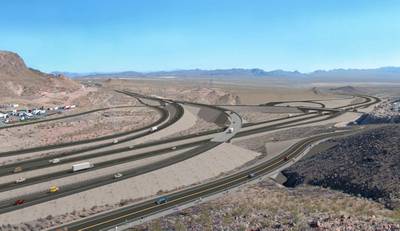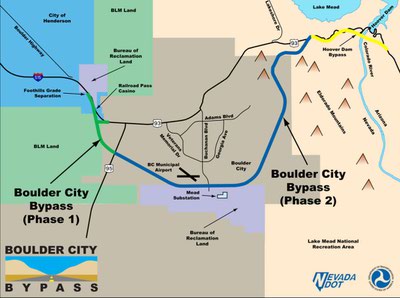
Courtesy Julie Duewel / Nevada Department of Transportation
Traffic is seen Jan. 13, 2011, on Interstate 15 in a construction zone for the Interstate 15 South Design-Build South Project. I-15 improvements topped a list of road projects that could bring an economic benefit to Nevada, but most projects are on a wish list because of a lack of available funding.
Wednesday, March 23, 2011 | 3:47 p.m.
Related Document (.pdf)
Sun Coverage
Sun Archives
- Construction work will prompt I-15 closure for two nights (2-13-2011)
- Engineering marvel taking shape near Hoover Dam (2-8-2010)
- Boulder City Council endorses Vegas-to-Phoenix interstate (8-12-2009)
- Freeway to Phoenix gains traction with bridge work (7-11-2009)
- Meeting planned to discuss changes to Boulder City Bypass (7-6-2009)
- Contractor selected for $270 million I-15 project (7-1-2009)
You’ve got to spend money to make money. That was the conclusion of a national transportation research group that released a report Wednesday outlining the top 40 transportation projects that would support economic growth in Nevada.
Call it a wish list for the Nevada Department of Transportation and the Regional Transportation Commission of Southern Nevada, which unveiled the study’s findings at a news conference, alongside Will Wilkins, executive director of the nonprofit, Washington, D.C.-based group TRIP.
Some of the projects, such as improvements to Interstate 15 in Clark County, already are under way, said Rudy Malfabon, deputy director for NDOT in Southern Nevada. Those were the top two projects listed by TRIP.
Others are somewhere in the pipeline, waiting for environmental impact studies to be completed or for funding to become available. On the whole, Malfabon said TRIP’s list closely matched NDOT’s priorities.
So, how to pay for it all?
The answer is unknown, said Jacob Snow, director of the transportation commission. But the purpose of Wednesday’s event, he said, was to explain how improving the state’s infrastructure could lead to much-needed economic growth.
“We’ve seen over and over again that communities that make an investment in infrastructure have an economic advantage over those that don’t,” Snow said. “You can’t afford to send a message, while we’re trying to recover from a recession, that you can’t get to and from Nevada reliably.”
Those investments can come with a hefty price tag. Nevada has a backlog of more than $10 billion in road projects, Snow said. One other suggestion on the list, improving and widening I-15 from the Spaghetti Bowl to south of Sahara Avenue, would cost $500 million alone.
Seven of the top 10, and 26 of the 40, identified projects are in Clark County. Those included expanding and improving U.S. 93 and U.S. 95 near Boulder City and Hoover Dam, extending U.S. 95 from Washington Avenue to Kyle Canyon Road, improving I-15 from Sloan to the state line and improving U.S. 95 from I-15 to Horizon Drive.

This artist's rendering shows what the redesigned interchange of Boulder City Bypass and U.S. 93 would look like at Railroad Pass. Railroad Pass Casino is at left. If U.S. 93 is designated an interstate between Las Vegas and Phoenix, the bypass route would become part of the interstate, officials say.
Snow referenced the Interstate 11 project, which has been proposed as a way of alleviating the traffic influx through Boulder City since the Hoover Dam bypass bridge opened in November.
Las Vegas and Phoenix are the only neighboring metro areas in the U.S. with populations of 1 million or more that aren't connected by an interstate, Snow said. About 9 percent of all visitors to the valley take that route from Arizona, and they spend more than $1 billion each year. A commonly floated price tag for the Nevada portion of that project is $330 million.
Part of the problem, Snow said, is Nevada grew too quickly. Even though the recession has battered the state’s economy in recent years, many of the projects remain necessary to stimulate its recovery, he said.
“As long as I can remember, we’ve been playing catch-up with all the infrastructure needs of this community,” Snow said. “We’ve been playing catch-up for so long, we still see and experience on a daily basis the lack of infrastructure. It’s always evident as we try to get from one place to another in the valley.”
Along with encouraging tourism, transportation construction would have obvious benefits for those in the battered construction industry, the report noted.
In a 2007 analysis, the Federal Highway Administration found that every $1 billion invested in highway construction supports about 27,800 jobs: 9,500 in construction, 4,300 in industries supporting the construction sector and about 14,000 other jobs in other areas of the economy.
Malfabon and Snow both said they had no easy answers on funding new projects. The transportation commission, which funds some projects through private money, has been forced to cut back its capital improvement fund in recent years, Snow said.
Increases in fuel taxes and vehicle registration fees could be possibilities, and both officials said they would support toll roads. Exploring public-private partnerships could also expedite some of the projects, Malfabon said.
The matter is largely in the hands of legislators, he added, saying NDOT rarely makes suggestions for funding mechanisms.
In the meantime, state lawmakers are in a battle over how to close a $2.2 billion budget shortfall.
“Money is tight, but there’s never been a better time to make an investment,” Snow said. “It’s a choice: do you make an investment in the economy or don’t you?”
TRIP examined data from NDOT, transportation commissions in Southern Nevada and Washoe County, the U.S. Department of Transportation, the Federal Highway Administration, the U.S. Bureau of Transportation and the U.S. Census Bureau in producing the report, Wilkins said.


Join the Discussion:
Check this out for a full explanation of our conversion to the LiveFyre commenting system and instructions on how to sign up for an account.
Full comments policy